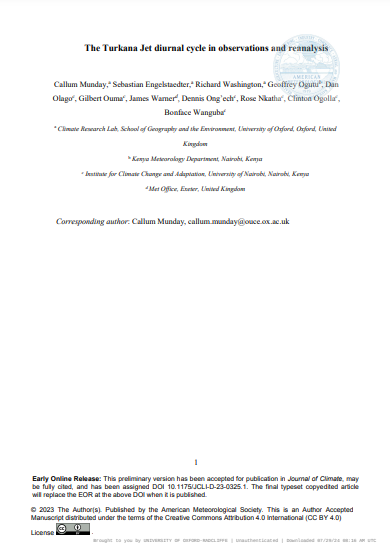Munday, C., Engelstaedter, S., Washington, R., Ogutu, G., Olago, D., Ouma, G., Warner, J., Ong’ech, D., Nkatha, R., Ogolla, C., and Wanguba, B.
The Turkana Jet is an equatorial low-level jet (LLJ) in East Africa. The jet influences both flooding and droughts, and powers Africa’s largest wind farm. Much of what we know about the jet, including the characteristics of its diurnal cycle, derives from reanalysis simulations which are not constrained by radiosonde observations in the region. Here, we report the characteristics of the Turkana Jet with data from a field campaign during March-April 2021 – The Radiosonde Investigation For the Turkana Jet (RIFTJet). The southeasterly jet forms on average at 380 m above the surface, with mean speeds of 15.0 m.s−1. The strongest low-level winds are during the night and early morning from 0300 LT to 0600 LT (>16 m.s−1). The average wind profile retains a characteristic low-level jet structure throughout the day, with the low-level wind maximum weakening to a minimum of 10.9 m.s−1 at 1500 LT. There is significant shear, of up to 1.5 m.s−1 per 100 m maintained through the 1000 m above the wind maximum. The diurnal cycle of the jet is associated with the nocturnal strengthening and lowering of elevated subsidence inversions, which form above the jet. Reanalysis simulations (ERA5 and MERRA2) do not capture the daytime persistence of the jet and underestimate the speed of the jet throughout the diurnal cycle. The largest absolute errors of over 4.5 m.s−1 (−35%) occur at 0900 LT. The reanalyses also fail to simulate the elevated subsidence inversions above the jet and associated dry layer in the lower troposphere.

